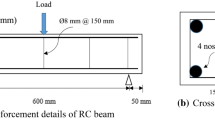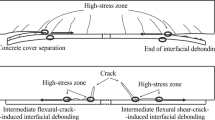Abstract
As an important component, the bond behavior of carbon fiber-reinforced polymer (CFRP)–concrete interface for a reinforced concrete (RC) beam is very significant. In this study, a theoretical model was established to analyze the flexural behavior of CFRP-strengthened RC beams, and the CFRP–concrete interfacial bond–slip relationship under hygrothermal environment was unified into one model. Two failure criteria corresponding to two types of failure modes, i.e., concrete crushing and intermediate crack (IC)-induced debonding, were developed. Through the theoretical model, the flexural behavior of deflection, interfacial shear stress distribution and ultimate load of a CFRP-strengthened RC beam under hygrothermal environment were obtained and predicted. Moreover, the theoretical model was verified by test results. The results showed that the hygrothermal environment had a significant impact on the CFRP–concrete interface behavior. Compared with the control beam without hygrothermal environment pretreatment, the deflection and ultimate load of the strengthened RC beam decreased by 51.9% and 20%, respectively.








Similar content being viewed by others
References
Frigione M, Aiello M, Naddeo C. Water effects on the bond strength of concrete/concrete adhesive joints. Constr Build Mater. 2006;20:957–70.
Cromwell J, Harries K, Shahrooz B. Environmental durability of externally bonded FRP materials intended for repair of concrete structures. Constr Build Mater. 2011;25:2528–39.
Li G, Pang S, Helms J, Mukai D. Stiffness degradation of FRP strengthened RC beams subjected to hygrothermal and aging attacks. J Compos Mater. 2002;36(7):795–812.
Karbhari VM, Engineer M. Effect of environmental exposure on the external strengthening of concrete with composites -short term bond durability. J Reinf Plast Compos. 1996;15(12):1191–216.
Li GQ, Pang SS, Helms JE. Stiffness degradation of FRP strengthened RC beams subjected to hygrothermal and aging attacks. J Compos Mater. 2002;36(07):795–812.
Gheorghiu C, Labossière P, Raiche A. Environmental fatigue and static behavior of RC beams strengthened with carbon-fiber-reinforced polymer. J Compos Constr. 2004;8(3):211–8.
Haber ZB, Mackie KR, Zhao L. Mechanical and environmental loading of concrete beams strengthened with epoxy and polyurethane matrix carbon fiber laminates. Constr Build Mater. 2012;26(1):604–12.
Qin G, Huang PY, Zhou H, Guo XY, Zheng XH. Fatigue and durability behavior of RC beams strengthened with CFRP under hot-wet environment. Constr Build Mater. 2016;111:735–42.
Buyukozturk O, Gunes O, Karaca E. Progress on understanding debonding problems in reinforced concrete and steel members strengthened using FRP composites. Constr Build Mater. 2004;18(1):9–19.
Abu Hassan S, Gholami M, Ismail YS, Sam ARM. Characteristics of concrete, CFRP bonding system under natural tropical climate. Constr Build Mater. 2015;77:297–306.
Hashim M. Durability and performance of carbon fiber reinforced polymer-concrete bonding system under tropical climate. Johor Bahru: Universiti Teknologi Malaysia; 2010. p. 325.
Ren HT, Hu AN, Yao QF. The influence of wet-thermal condition on durability behavior of concrete structures strengthened by FRP. J Harbin Inst Technol. 2006;38(11):1996–9.
Wan B, Petrou MF, Harries KA. Effect of the presence of water on the durability of bond between CFRP and concrete. J Reinf Plast Compos. 2006;25(8):875–90.
Ouyang Z, Wan B. Experimental and numerical study of moisture effects on the bond fracture energy of FRP/concrete joints. J Reinf Plast Compos. 2008;27(2):205–23.
Hugo Biscaia C, Silv MAG, Chastre C. An experimental study of GFRP-to-concrete interfaces submitted to humidity cycles. Compos Struct. 2014;110(1):354–68.
Liu JX. Study on the mechanical properties of CFRP-concrete bonding interface on hygrothermal environment. Chongqing: Chongqing Jiaotong University; 2016.
Zheng XH. Study on the bond-slip mechanism of CFL-concrete interface under hot/wet environment. Guangzhou: South China University of Technology; 2014.
Bennegadi ML, Hadjazi K, Sereir Z, Amziane S, El Mahi B. General cohesive zone model for prediction of interfacial stresses induced by intermediate flexural crack of FRP-plated RC beams. Eng Struct. 2016;126:147–57.
Perera R, Bueso-Inchausti D. A unified approach for the static and dynamic analyses of intermediate debonding in FRP-strengthened reinforced concrete beams. Compos Struct. 2010;92:2728–37.
Razaqpur AG, Lamberti M, Ascione F. Debonding evolution in nonlinear FRP-retrofitted RC beams with cohesive interface. Compos Struct. 2020;236:111858.
Faella C, Martinelli E, Nigro E. Formulation and validation of a theoretical model for intermediate debonding in FRP-strengthened RC beams. Compos Part B Eng. 2006;39:645–55.
Popovics S. A numerical approach to the complete stress–strain curve of concrete. Cem Concr Res. 1973;3(5):583–99.
Guo XY, Shu SYH, Wang YL, Huang PY. Effect of subtropical natural exposure on the bond behavior of FRP-concrete interface. Polymers. 2020;12:967. https://doi.org/10.3390/polym12040967.
Lorenzis, L.D. Strengthening of RC structures with near surface mounted FRP rods. M.S. Thesis, Dept. of Civil Engineering, Univ. of Missouri-Rolla. 2000.
Hoque N, Jumaat MZ, Sulong NHR. Global energy balance-based debonding modeling of NSM FRP-strengthened concrete beam. J Compos Constr. 2020;24(1):04019053.
Achintha PMM, Burgoyne C. Fracture mechanics of plate debonding. J Compos Constr. 2008;12(4):396–404.
Karihaloo BL, Abdalla H, Imjai T. A simple method for determining the true specific fracture energy of concrete. Mag Concr Res. 2003;55(5):471–81.
Wang YL, Guo XY, Huang PY, Huang KN, Yang Y, Chen ZB. Finite element investigation of fatigue performance of CFRP-strengthened beams in hygrothermal environments. Compos Struct. 2020;234:111676.
Acknowledgements
The authors would like to acknowledge the financial support from the National Natural Science Foundation of China (Nos. 11872185, 11627802, 51678249, 11132004) and the Natural Science Foundation of Guangdong Province (No. 2019A1515012222).
Author information
Authors and Affiliations
Corresponding author
Rights and permissions
About this article
Cite this article
Guo, X., Huang, P., Wang, Y. et al. Flexural Performance of Reinforced Concrete Beams Strengthened with Carbon Fiber-Reinforced Polymer (CFRP) under Hygrothermal Environment Considering the Influence of CFRP–Concrete Interface. Acta Mech. Solida Sin. 34, 381–392 (2021). https://doi.org/10.1007/s10338-020-00207-7
Received:
Revised:
Accepted:
Published:
Issue Date:
DOI: https://doi.org/10.1007/s10338-020-00207-7




